A bull’s €uro-Star figures dropping is very frustrating for a farmer that had used that bull based on his figures before they changed. In the following article, ICBF uses a Limousin AI bull ‘Wilodge Cerberus’ (WGE) to explain why a bull’s index can change.
In May 2018 he is €48 (1 star) for ‘Replacement Index’ with a reliability of 90%. In May 2017 he was €111 (5 stars) for ‘Replacement Index’ with a reliability of 83%.
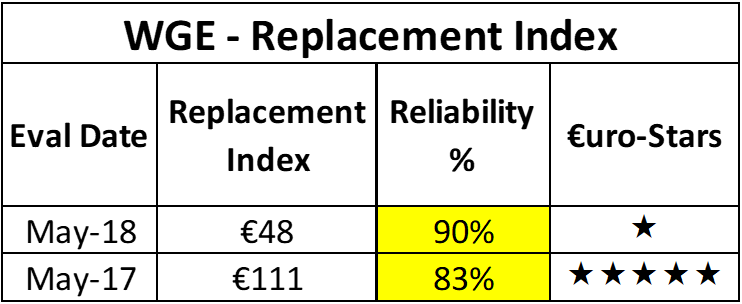
Q1. What are the main reasons for the bulls figures dropping from 5 star to one star in one year given his reliability % was already high with over 1000 progeny included in the evaluation?
Reliability %: 80% reliability for an overall index is not extremely high – there is still room for movement. It is only when a bull goes over 95% reliable that his index will remain extremely stable.
Replacement Index Structure:
‘WGE’ progeny were found to perform well for the main beef and calving traits which makes up 55% of the overall ‘Replacement Index’. So he started out with a good index.
It was only then later on when ‘Milk’ and ‘Fertility’ could be recorded on his daughters after they calved that it was found they were far heavier and not as fertile as the other cows in their herds.
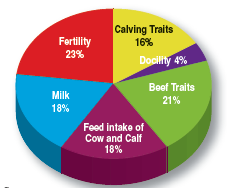
40% of the ‘Replacement Index’ is made up of beef traits, as we need our suckler cows to have good conformation as well as good milk and fertility. He has always been rated highly for the beef traits which are always the first traits to be collected on a bull’s progeny so his Terminal Index has always been high and until large numbers of his daughters started calving for a second time his ‘Replacement Index’ was being largely driven by his beef traits e.g. carcass weight. However, the maternal aspect of a bull’s proof is always the last piece of the jigsaw and it is that part of his ‘Replacement Index’ that is now affecting ‘WGE’s’ overall figure.
Daughter Fertility: The main reason that the Replacement Index for ‘WGE’ has decreased is because it is only now that the fertility performance of his daughters has become fully known. He does have over 1000 calves born in Ireland but it is only his daughters that calve that contribute to his fertility index.
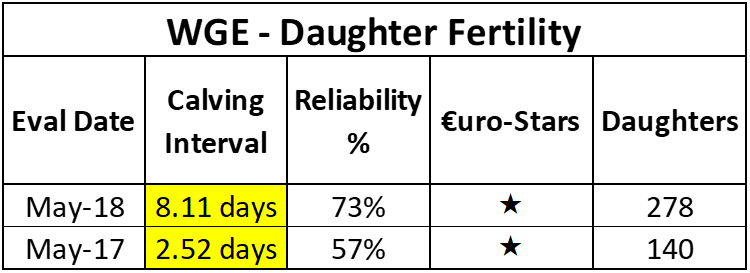
Given that ‘Calving Interval’ is a lowly heritable trait, you need a lot more records to lift its reliability% than you would for other more highly heritable traits such as calving difficulty. So although he has sired over 1000 calves, in May 2017 he only had 140 cows with calving interval figures. The performance of his daughters for fertility in Irish herds and the data returned on him by Irish farmers always had him rated as a 1 or 2 star bull for calving interval.
Cow Liveweight: His daughters were found to be 17kgs heavier and 1.5 parities younger than their herdmates. Given the number of his daughters that have been weighed, mainly through the WHPR program, this information is now 97% reliable.

Genomics: He was also only genotyped in December 2017 which also contributed to his ‘calving interval’ index decreasing and his terminal traits increasing. If he had been genotyped earlier then this reduction in his proof would have happened earlier in his career.
Q2.Why has this change only occurred in the past year subsequent to numerous years as a highly ranked bull?
He was never ranked highly for ‘Calving Interval’. His overall ‘Replacement Index’ was being helped greatly by his excellent terminal traits but both his index for ‘Calving Interval’ and the reliability of same were always low.
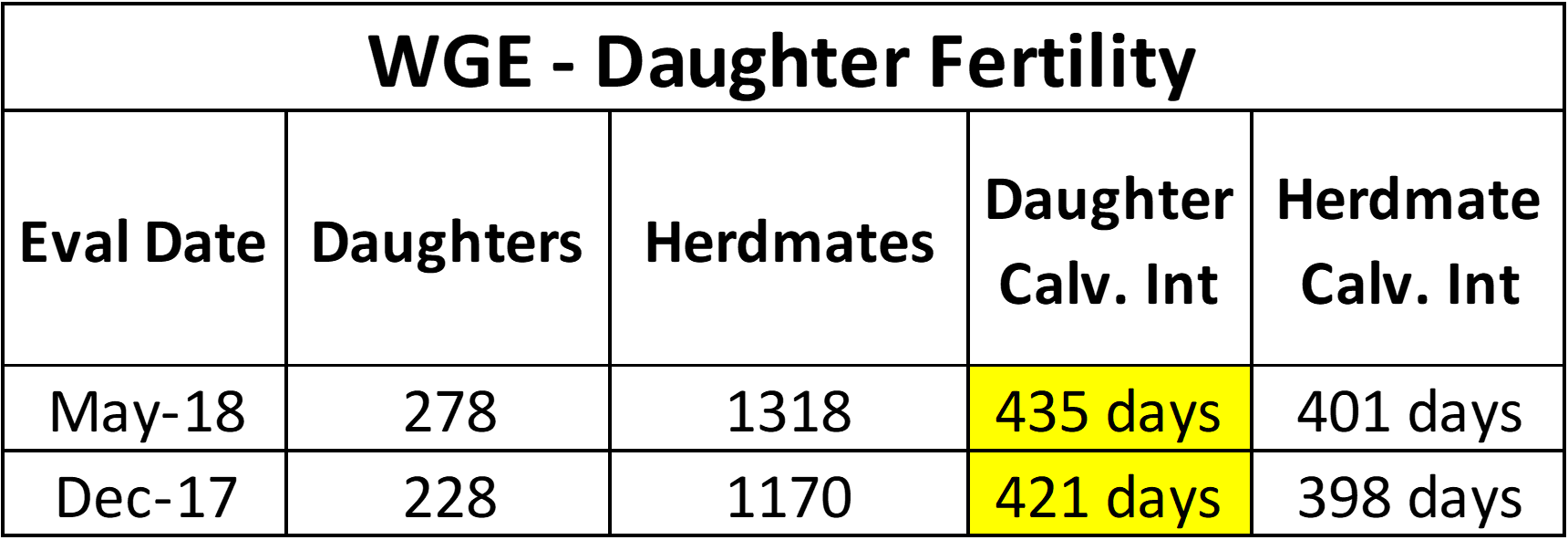
He gained an extra 50 daughters in his proof in May 2018 and the average ‘Calving Interval’ of his daughters disimproved by 2 weeks and was further behind that of their herdmates who calved in the same herds.
Q3.Is it common for bulls with such a high reliability behind their index to drop so severely in the space of a year?
His ‘Calving Interval’ index reliability % was only at 57% which indicates that there is large room for movement. Even for an overall index reliability of 80% there is still room for movement, especially when there is such a shift in performance for a trait as economically important as ‘calving interval’.
Q4.His sire Wilodge Tonka has a replacement value of €132 at 87% reliable. With his son seeing such a drop is it likely his index will change over the coming months?
WTA has 262 daughters of his own in Ireland and their calving intervals, although behind that of their herdmates, the difference is not as great as it is for WGE:
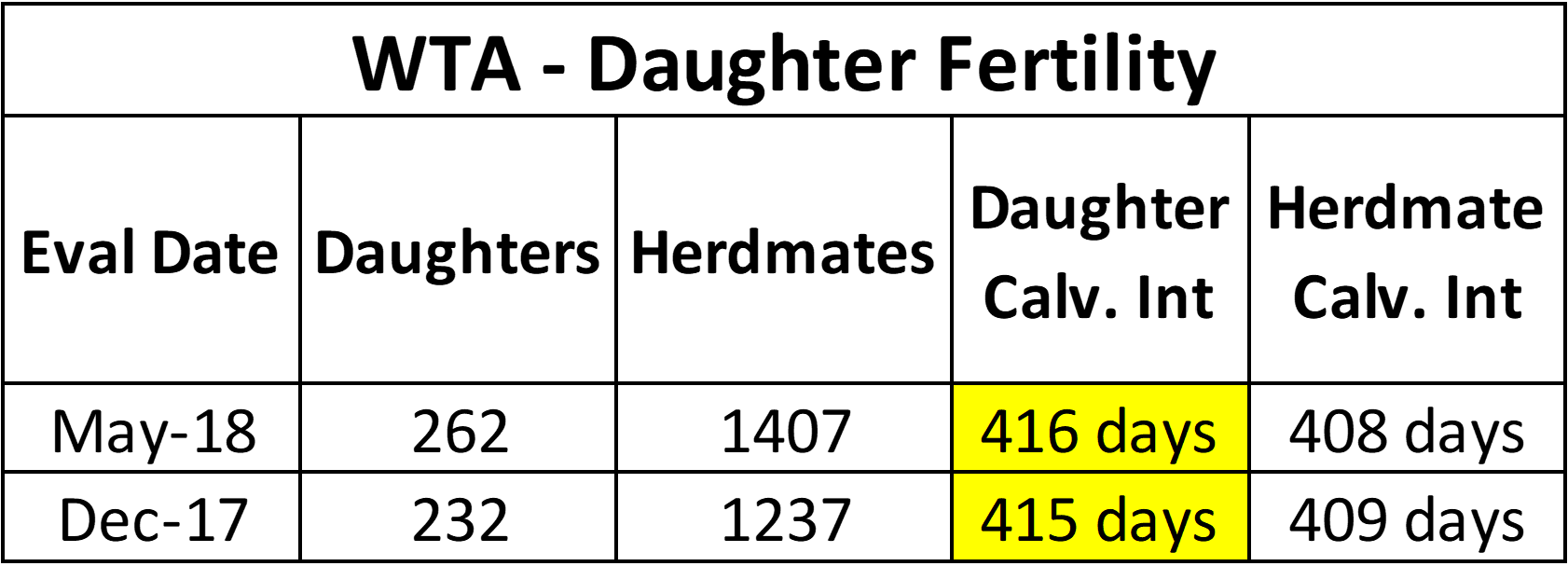
His reliability for ‘Calving Interval’ is 71% so again there is room for movement but compared to WGE the on the ground performance of his daughters to-date is better. Another point to note on him is that he is not genotyped – again if he was this could also move his figures but will always increase his reliability%.
Q5.What impact does UK data have on his proof?
UK data is used for the calving, weight and milk traits but is currently not sent to us for the fertility traits. It is however planned to include it as part of the international sharing of beef evaluations project called ‘Interbeef’ which is making great progress in this area. That said, for this bull, given the number of daughters that he now has here together with his genotype tells us everything about his genetic ability, without including UK data.
Q6.At what number of progeny will the level of fluctuation on stars drop?
That depends on the trait. Normally once an AI bull is already genotyped and is over 95% reliable then the expected movements of the proof will be small.
Q7.Is there a chance Wilodge Cerberus will return to five stars before he is fully proven?
He is currently at 73% reliable for calving interval so there is room for change but if his daughters continue to demonstrate their current poor fertility performance then this is unlikely.
Q8.A lot of his daughters were flushed for embryo transfer work, would this have affected his figures?
No, these daughters are always excluded from his €uro-Star calculations.
Q9.In general his progeny exhibit superb conformation and have done well at shows and achieved very high prices at sales, is this not taken into account?
His ‘Terminal Index’ which includes the traits that would contribute to show success and visually looking very well such as carcass weight, conformation and muscle, has always been in ‘5 star’ territory. The ‘Replacement Index’, as already explained includes a mixture of these traits together with the maternal traits of milk and fertility. It is these maternal traits that disimproved and caused his drop in index.

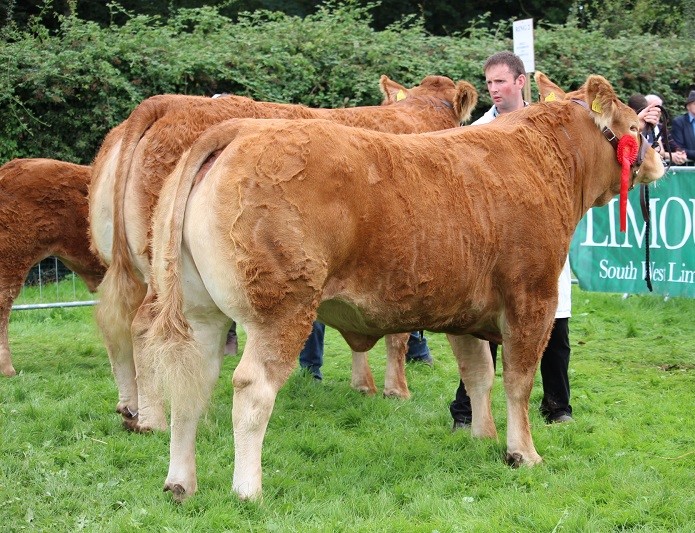
Q10.How do Breeders protect themselves against using bulls whose figures drop?
- Pay close attention to reliability%. If a bull is under 95% for the ‘Replacement Index’ he should not be over used.
- Use ‘teams’ of bulls otherwise new bloodlines will not be discovered. However make sure that some high reliability bulls are part of your team.
- Support the ‘Gene Ireland’ progeny test program. By routinely progeny testing young bulls with high ‘replacement index’ figures you will have a wider selection of proven AI Sires with high reliability % figures from which to choose from.
All of the data used in this article is freely available on the ICBF website. Enter an animal’s tag number into the ‘Animal Search’ and then click on the tabs to find out more about how an animal’s index is calculated.
Link to Article in PDF form –> Case Study of a Bull – WGE
This article has been prepared by ICBF in good faith on the basis of information provided to it. No representation or warranty expressed or implied is made or given by ICBF as to the accuracy, reliability, completeness of this article. ICBF shall not be liable for any losses (whether direct or indirect), damages, costs or expenses whatsoever, incurred or arising from any use of or reliance on this article or the information contained in it by any person.
